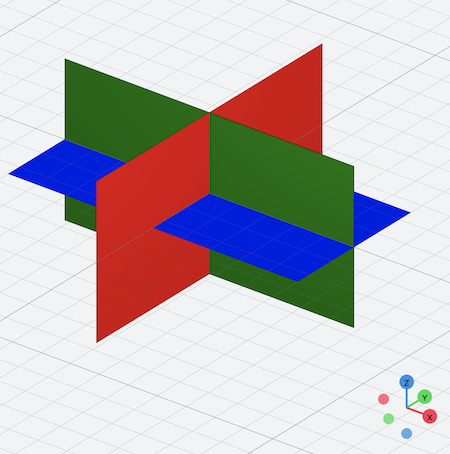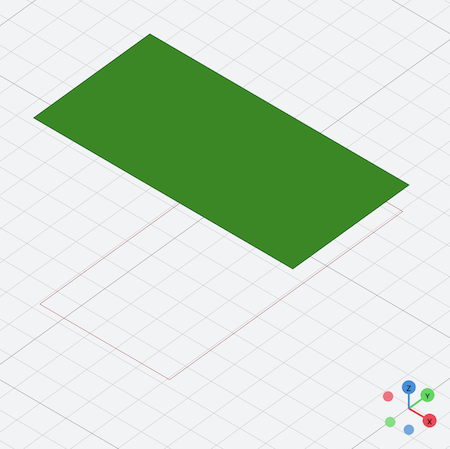Planes and Sketches
We have so far drawn on the 2D plane. But we want to put these drawings in 3D space. For this we will need to define a plane and sketch the drawing into it.
Sketching
In order to show the planes we will need to sketch on them.
const { drawRoundedRectangle } = replicad;
const main = () => {
return drawRoundedRectangle(100, 50).sketchOnPlane();
};
By default this sketches on the XY plane.
Planes
Now that we know what sketching is, we can see the way to create planes.
Standard planes
There are a bunch of standard planes defined as a string
const { drawRoundedRectangle, makePlane } = replicad;
const main = () => {
const rect = drawRoundedRectangle(100, 50);
return [
{ shape: rect.sketchOnPlane(makePlane("XY")), name: "XY", color: "blue" },
{ shape: rect.sketchOnPlane(makePlane("XZ")), name: "XZ", color: "green" },
{ shape: rect.sketchOnPlane(makePlane("YZ")), name: "YZ", color: "red" },
];
};

Planes parallel to the standard one
There are a bunch of standard planes defined as a string
const { drawRoundedRectangle, makePlane } = replicad;
const main = () => {
const rect = drawRoundedRectangle(100, 50);
return [
{ shape: rect.sketchOnPlane(makePlane("XY")), name: "At 0", color: "blue" },
{
shape: rect.sketchOnPlane(makePlane("XY", 20)),
name: "At 20",
color: "green",
},
{
shape: rect.sketchOnPlane(makePlane("XY", -20)),
name: "At -20",
color: "red",
},
];
};
Sketching shortcut
As these are common ways to sketch a drawing, we have implemented a shortcut
within the sketchOnPlane method.
const { drawRoundedRectangle } = replicad;
const main = () => {
return drawRoundedRectangle(100, 50).sketchOnPlane("XZ", 10);
};
Opposite standard planes
In addition to the standard planes there are their opposite (YX is the
opposite of XY). These are the same planes, but with their axis inverted
– which also means top and bottom are inverted.
An example will make it more concrete
const { drawRoundedRectangle, makePlane } = replicad;
const main = () => {
const rect = drawRoundedRectangle(100, 50);
return [
{ shape: rect.sketchOnPlane("XY", 20), name: "XY at 20", color: "green" },
{ shape: rect.sketchOnPlane("YX", 20), name: "YX at 20", color: "red" },
];
};

We can see that the rectangle has been rotated to match the axis, but also that the direction of the plane is reversed.
Transforming planes
We might want to use planes more different than translations of the origin along the normal of a plane. Note that the order in which you apply these transformations might change the final result.
Translations
We might want to translate the origin of an arbitrary position. Note that the general direction of the plane is the same. Only the origin point has been changed.
const { drawRoundedRectangle, makePlane } = replicad;
const main = () => {
const plane = makePlane("XZ").translate(-50, 50, 20);
return drawRoundedRectangle(100, 50).sketchOnPlane(plane);
};
Pivot
We might want to give an angle to our plane. In order to do this, we can pivot
the plane around its origin and an axis (which can be a standard direction X, Y, Z, or a generic direction ([1, 1, 0])
const { drawRoundedRectangle, makePlane } = replicad;
const main = () => {
const plane = makePlane("XY").pivot(30, "Y");
return drawRoundedRectangle(100, 50).sketchOnPlane(plane);
};
Axes rotation
There is a last operation that can be done on a plane - it is the rotation of its axes around the origin.
const { drawRoundedRectangle, makePlane } = replicad;
const main = () => {
const plane = makePlane("XY").rotate2DAxes(30, "Y");
return drawRoundedRectangle(100, 50).sketchOnPlane(plane);
};
Summary
You can look at the different operations with the same base plane and drawing.
const { drawRoundedRectangle, makePlane } = replicad;
const main = () => {
const rect = drawRoundedRectangle(100, 50);
const plane = makePlane("XY", 10);
return [
{ shape: rect.sketchOnPlane(plane), name: "Base", opacity: 0.5 },
{
shape: rect.sketchOnPlane(plane.translateY(-70)),
name: "Translated",
opacity: 0.5,
color: "green",
},
{
shape: rect.sketchOnPlane(plane.pivot(30)),
name: "Pivoted",
opacity: 0.5,
color: "orange",
},
{
shape: rect.sketchOnPlane(plane.rotate2DAxes(30)),
name: "Rotated",
opacity: 0.5,
color: "purple",
},
];
};
Practicing with the watering can tutorial
You can have a look at a practical example of using the drawing API with the watering can tutorial